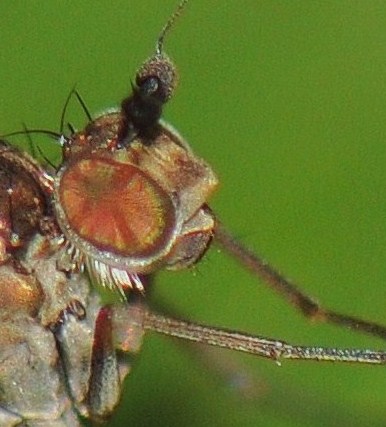Diptera.info :: Identification queries :: Diptera (adults)
Who is here? 1 guest(s)
|
Dolichopodidae muppet face>Syntormon denticulatum
|
|
| blowave |
Posted on 14-10-2010 02:10
|
|
Member Location: LINCOLN, UK Posts: 3151 Joined: 27.06.07 |
Hello!  Orange flies have to wait, this is too funny! 13th October, on a leaf overhanging water near the Ivy! Approx. 5.5mm. My garden near Lincoln UK. 3 pics Janet 
blowave attached the following image:  [84.29Kb] Edited by blowave on 21-10-2010 11:42 http://cubits.org... |
| blowave |
Posted on 14-10-2010 02:11
|
|
Member Location: LINCOLN, UK Posts: 3151 Joined: 27.06.07 |
pic 2
blowave attached the following image:  [86.45Kb] http://cubits.org... |
| blowave |
Posted on 14-10-2010 02:11
|
|
Member Location: LINCOLN, UK Posts: 3151 Joined: 27.06.07 |
pic 3
blowave attached the following image:  [125.73Kb] http://cubits.org... |
| Paul Beuk |
Posted on 14-10-2010 09:12
|
|
Super Administrator Location: Netherlands Posts: 19403 Joined: 11.05.04 |
Syntormon?
Paul - - - - Paul Beuk on https://diptera.info |
| blowave |
Posted on 14-10-2010 14:39
|
|
Member Location: LINCOLN, UK Posts: 3151 Joined: 27.06.07 |
Syntormon was the genus I had thought too Paul, there's not one in the gallery which matches mine though. S. pallipes female comes close but it doesn't appear to have the muppet face.  Besides that there is Besides that there is bicolorellum and pumilus Here's a list of the species we have.. 16 species! http://www.dipter...hp?id=9457 http://cubits.org... |
| blowave |
Posted on 14-10-2010 21:26
|
|
Member Location: LINCOLN, UK Posts: 3151 Joined: 27.06.07 |
I have looked at a key for Syntormon an come up with Syntormon denticulatum. http://www.fortun...tormon.htm 3.– Females; face broad; clypeus convex ... 15 20. – Fore coxa with white hairs, sometimes with 1-2 black setae at apex; frons brownish pollinose; fore tibia with anterodorsal serration; mid coxa without strong setae ... denticulatus(Zetterstedt) 23. Frons mat, bronze-green ... denticulatus (Zetterstedt) Have I done this correctly? blowave attached the following image:  [63.66Kb] http://cubits.org... |
| blowave |
Posted on 14-10-2010 21:27
|
|
Member Location: LINCOLN, UK Posts: 3151 Joined: 27.06.07 |
Fore tibia..
blowave attached the following image:  [62.53Kb] http://cubits.org... |
| Marc Pollet |
Posted on 14-10-2010 23:04
|
|
Member Location: Welle (Denderleeuw) Posts: 161 Joined: 02.06.05 |
Sir, Syntormon denticulatum would be my best guess too, on the basis of the bare face and the dark legs. Perhaps you could only check if S. zelleri shows very different features, although this species is much rarer than S. denticulatum and occurs in more oligotrophic habitats and at primarily at high altitudes. Cheers, Marc Marc Pollet |
|
|
|
| Marc Pollet |
Posted on 14-10-2010 23:05
|
|
Member Location: Welle (Denderleeuw) Posts: 161 Joined: 02.06.05 |
Sir, Syntormon denticulatum would be my best guess too, on the basis of the bare face and the dark legs. Perhaps you could only check if S. zelleri shows very different features, although this species is much rarer than S. denticulatum and occurs in more oligotrophic habitats and at primarily at high altitudes. Cheers, Marc Marc Pollet |
|
|
|
| Roger Thomason |
Posted on 14-10-2010 23:20
|
|
Member Location: Mossbank,Shetland Isles. Posts: 5268 Joined: 17.07.08 |
Marc Pollet wrote: Sir, Syntormon denticulatum would be my best guess too, on the basis of the bare face and the dark legs. Perhaps you could only check if S. zelleri shows very different features, although this species is much rarer than S. denticulatum and occurs in more oligotrophic habitats and at primarily at high altitudes. Cheers, Marc Marc Pollet Didn't know the sex change had been completed Janet...what do we call you now...Blow what? |
|
|
|
| blowave |
Posted on 15-10-2010 00:39
|
|
Member Location: LINCOLN, UK Posts: 3151 Joined: 27.06.07 |
Thank you Marc. I found a photo of only a male S. zelleri on the same site, although I have some more keys in a pdf which I will take a look at as the key above doesn't look to have S. zelleri included. http://dolicho.na...lleri.html Roger, I know what you would be calling me! 
http://cubits.org... |
| blowave |
Posted on 15-10-2010 02:46
|
|
Member Location: LINCOLN, UK Posts: 3151 Joined: 27.06.07 |
Marc, I have checked the key on the pdf. All seems to fit Syntormon denticulatum. 15. Mid tibia with 3 anterodorsal, 1-2 posterodorsal and 1 ventral setae; antennal stylus 1.5 times longer than postpedicel (along dorsal margin); m-cu shorter than distal part of CuA1; lower calyper with white cilia; 2.5-4.0 ....... ..............................................................................denticulatus (Zetterstedt) http://www.dipter...Europe.pdf Again, S. zelleri is not listed. Can I say for certain this is Syntormon denticulatum.? It would be a good addition to the gallery! Mid tibia.. blowave attached the following image:  [43.2Kb] http://cubits.org... |
| blowave |
Posted on 21-10-2010 11:41
|
|
Member Location: LINCOLN, UK Posts: 3151 Joined: 27.06.07 |
I am now confident this is Syntormon denticulatum http://www.dipter...3055#p3055 http://cubits.org... |
| Igor Grichanov |
Posted on 25-10-2010 09:56
|
|
Member Location: St.Petersburg, Russia Posts: 1795 Joined: 17.08.06 |
Syntormon denticulatus (Zetterstedt, 1843) (-us; F -um) [Rhaphium] (Loew, 1857: Progr.Realsch.Meseritz 1857: 34-35) Syntormon bicolorellus (Zetterstedt, 1843) Syntormon pumilus (Meigen, 1824) etc. The author of the genus (Loew) used Syntormon denticulatUS (Zetterstedt, 1843) for Rhaphium denticulatUM Zetterstedt, 1843. Therefore, masculine gender must be applied to all Syntormon species. Igor Grichanov |
| blowave |
Posted on 25-10-2010 16:59
|
|
Member Location: LINCOLN, UK Posts: 3151 Joined: 27.06.07 |
Thank you Igor, I'll wait to see if Paul sees this. If not I will contact him to make the change from denticulatum to denticulatus. http://cubits.org... |
| Jump to Forum: |













